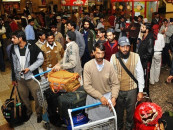Cost of disaster
.

After endless torrents of rainfall and flash floods that have lasted for several months in Pakistan, the most recent report cites at least 1,006 deaths across the country, marking one of the deadliest monsoon seasons in past years.
There is always a cost to natural disasters. The destruction of housing infrastructure, roads, power lines, water supply systems, crops, livestock and factories all amounts to a numerical brunt that is shouldered by entire communities. For example, the submersion under floodwater of both rural regions and industrial centres alike is not a regular occurrence in Pakistan. But this year, massive floods have wreaked havoc across the country without discrimination. According to the government, the floods have disrupted supply chains and could possibly be cause for further inflation.
But the hidden cost of natural disasters — one that cannot be put into numbers — is the grief that follows loss, and the mental fortitude one requires to rebuild their life. Of the 1,006 deaths, 275 bodies were of children who were perhaps not even old enough to comprehend why their city was suddenly falling apart. Along with 275 children, 568 men and 163 women lost their lives across all provinces. These statistics are not mere tools to gauge the extent of the city's destruction compared to previous years, but rather individual families that have been torn apart because of neglect and a lack of preparedness.
Rescue and relief operations are now underway as authorities connect with displaced communities, trying to figure out what medicine or aid could soften the blow of grief. It is incumbent upon the government to restore what can be restored and rebuild what has been destroyed of livelihoods. Now is the time for officials to regain the trust of their communities, which was swept away in these torrential waters.















COMMENTS (1)
Comments are moderated and generally will be posted if they are on-topic and not abusive.
For more information, please see our Comments FAQ